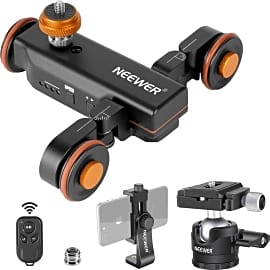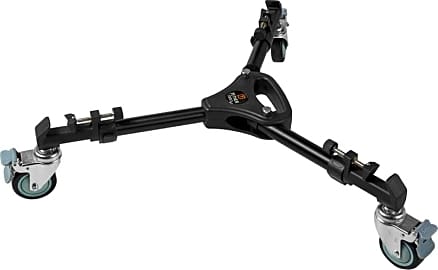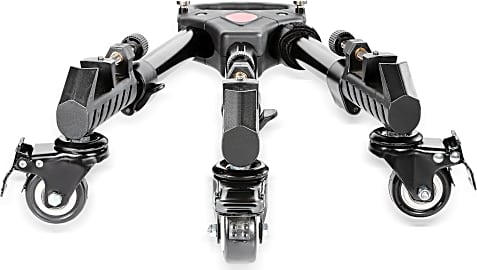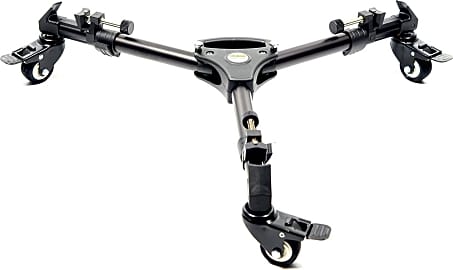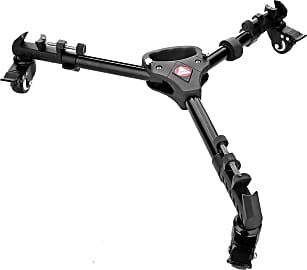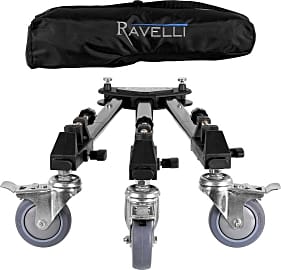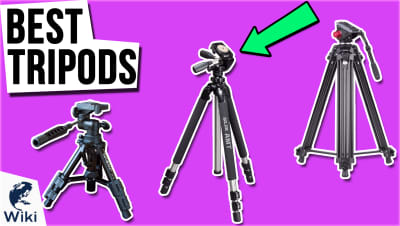The 10 Best Tripod Dollies

This wiki has been updated 37 times since it was first published in April of 2016. If you're a videographer or cinematographer trying to achieve a smooth tracking shot without access to a Hollywood-sized budget, take a look at these tripod dollies. Designed to hold different types of gear, they are useful for quickly moving and repositioning your camera between setups. Many are also lightweight, and come with travel bags or carrying handles for portability. When users buy our independently chosen editorial recommendations, we may earn commissions to help fund the Wiki.
Editor's Notes
May 11, 2021:
For the most part, this list still looked to be in good shape, leaving us with little need to make any major changes to it, although we did still manage to find a few places to brush up on things, beginning by eliminating the Cowboy Studio Max, which previously held a low spot on our list, but was no longer available during this update.
We also replaced the Neewer Wireless with the Neewer 3-Wheels Motorized, which looks to be essentially the same option, but bundled with a helpful, low-profile ball head, which makes the unit a more practical choice for DSLR and mirrorless bodies up to 6.6 pounds. It does cost a bit more than our previous pick, but we felt that the boost in versatility was well worth the difference in price.
Finally, we added the Tether Tools Rock Solid to our list. This moderately priced option caught our eye with its notably light weight of less than five pounds, and we appreciated that it came with a serviceable carry bag — which is one place where some other options in this category fell short. The existing user reviews for this model were quite positive at the time of this writing, but there also weren’t very many to speak of, so we’ll keep a close eye on this option to see whether the good feedback is still rolling in when this list is ready for its next update.
Though there are some exceptions – like the the Neewer 3-Wheels Motorized – note that most models on this list won’t do you much good unless they’re paired with a serviceable tripod.
March 27, 2020:
Availability issues led to the removal of the Polaroid Foldable and Viltrox Weifeng. While reviewing the Neewer Professional, we noted its affordability and its ability to securely support both heavy and lightweight equipment for smooth rolling on various floor types. We upgraded this item.
We pointed out that the Glide Gear SYL works best if the wheels are lubricated from time to time. The Ravelli ATD Photo is a satisfactory solution for smooth surfaces, but if you’re planning to capture moving footage on outdoor terrain, you’ll probably want to look elsewhere.
Added the Kingjoy VX-600, a standard, budget-friendly dolly that folds up quickly for portability. Our other new addition — the Neewer Wireless — differs from the rest of the models in several ways: it’s designed only for smartphones and small cameras, and it comes with a remote control so you can dictate its movements from afar.
Special Honors
Hague D6 This universal dolly can be set to various height positions to get shots at the angle of your choosing. Two wheels have swivel locks, which you can activate to make it track in a straight line or in an arc. It comes with three straps for securing the tripod once it’s set up. haguecamerasupports.com
Miller HD Studio Despite its small footprint, this unit can support nearly 450 pounds, with rigid alloy arms that fold in when it needs to be transported or put into storage. The sturdy casters utilize a smooth swivel motion to help you capture steady footage, even when the camera is on the move. millertripods.com
Slidekamera Tripod Dolly Designed for use with large, heavy tripods, this model from Polish filmography equipment maker Slidekamera has easy-to-use knobs for adjusting and locking the legs in place. Each rubber wheel has a brake, and it’s built with a carrying handle for portability. slidekamera.pl
Increase Your Production Value
Rails systems by companies like Keiser can be relatively affordable, compared to professional, platform-boom dollies — which tend to be more costly.
If you compare the work of professional cinematographers in film and television to the litany of amateur short films that play at festivals around the world, you’re likely to notice one crucial difference about the camera movement. In amateur pieces, the camera is almost always either handheld or limited to a tripod with pans and tilts as moves. Rarely do you see a no-budget movie with long, smooth camera moves. Yet those moves are everywhere in cinema and TV.
It’s gotten a lot easier more recently to move a camera with some degree of smoothness. Back in the days of film, cameras were universally so big and heavy that they necessitated the kinds of professional dolly systems that are far outside the budget of independent filmmakers. Nowadays you can grab your iPhone and a handheld gimbal and create some stunningly smooth photography with enough resolution to get you into major festivals. And for shorter camera moves with small DSLRs that are capable of great video production, you can employ any of the relatively inexpensive sliders on the market.
But if your rig is big enough that it needs to be on a good tripod for stability, and if your move is long enough or complicated enough that you need something with more reach than a slider, then you have to have a dolly. Rails systems by companies like Keiser can be relatively affordable, compared to professional, platform-boom dollies — which tend to be more costly. That’s why the tripod dolly is so useful: it’s a much less expensive way to achieve very comparable results.
Once you start employing dolly and tracking shots in your films or other productions, the perceived quality of what you see on that screen will skyrocket. Even if you’re using inferior camera equipment to the next filmmaker, smooth handling can make your work seem like it cost a lot more money to make than it really did.
How To Choose The Right Tripod Dolly For Your Setup
For the most part, tripod dollies are pretty universal. They consist of telescoping arms with wheels mounted on the underside, and a set of clamps at the end of each arm to secure your tripod's feet in place. Figuring out which model is right for you is mostly a balancing act between the quality of each of those features and the amount of money you want to spend.
Next, look at the quality of the clamps used to lock your tripod in place.
In the case of the telescoping arms, the degree to which they can spread out will determine how easily your tripod will fit, and how stable it will be when the dolly is in motion. It’s important here that you set up your tripod at home and measure the distance from the ground beneath the center of the unit to its individual feet. That way, you’ll know whether a model is large enough to accommodate your tripod when it’s at its most stable configuration. If you have to bring the legs together a little to get it to fit, you’ll lose some stability.
Next, look at the quality of the clamps used to lock your tripod in place. They should seem as secure as possible, but they shouldn’t look like they might damage the legs of your tripod over time.
The quality and type of the wheels is important to check, as well. Some casters will provide smooth, quiet movement on indoor surfaces, but might not be able to stand up to exterior use on asphalt or concrete. If you need to use your dolly outdoors, look for a model with wheels that look like they came off a pair of inline skates; they should be rubbery and translucent.
The weight of a tripod dolly is also extremely important. If it’s too heavy, it’ll be tough to move and a pain to transport. If it’s too light, it won’t provide you with enough stability to keep your movements as smooth as they should be. Ideally, you can find something that’s light enough to carry around, and that also has a large enough center plate that you can easily lay a sandbag on it to add weight and stability to your shot.
Motivate Your Movement
Once you get your tripod dolly all set up and ready to roll, you’re going to be tempted to add a little bit of movement to pretty much every shot you compose. I’m here to warn you that that is not a good idea. If you dissect a lot of modern big budget movies and television, the camera does a lot of moving. Dollies, booms, cranes, jibs, and a dozen other tools are employed in the service of moving the camera, but often for the wrong reasons.
Use it where you must use it to help tell your story, and you’ll be surprised how much more deeply your viewers will connect.
On television in particular, static shots are often avoided for fear of losing the attention span of viewers. In independent films, camera moves are often employed as a plea to the audience to accept their work as professional. Both of these approaches are rife with folly.
If you want your camera to dolly in, or track along with a character, you’d better have a good reason for doing so. For example, if your character is having a revelation of some kind, realizing something they needed to know all this time, you could dolly in on their face. Practically, this brings us closer to the actor so we can see that revelation more clearly, but it also causes more of the frame to disappear as the world would fall away in the character’s mind, their entire sensory experience wrapped up in this new thought. That’s motivated camera movement.
Too often the camera moves for the sake of moving. Two characters sit at a table having a relatively banal conversation that’s more setup for the next few scenes than anything else, and the camera spins around them. Sure, this does make the scene a little less visually boring, but it’s also the kind of thing that critics and festival judges hate.
In short, be disciplined with your dolly. Use it where you must use it to help tell your story, and you’ll be surprised how much more deeply your viewers will connect.



